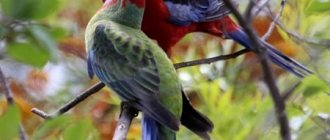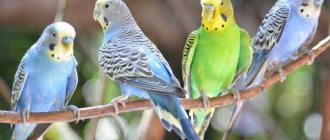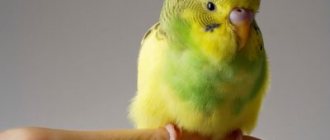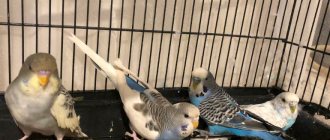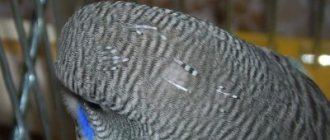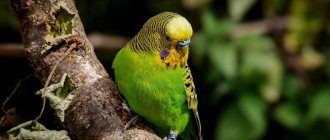To uninitiated people, the singing of budgies may seem like meaningless bird chatter. After all, parrots are not the usual dogs or cats, whose habits have long been studied and understood. However, they are the same living beings, having their own preferences, individual character and even personal opinion. With the help of bird trills and a special behavior characteristic of a particular case, a parrot can tell its owner about its needs, the joy of meeting a person, or, conversely, express dissatisfaction.
After reading the article, you will learn how to decipher bird language and learn to better understand your pet. You will also be able to see with your own eyes all the variety of dances and hear what sounds parrots are capable of making while living side by side with humans.
Singing budgerigars
All the names of budgies are in one way or another connected with the words “noisy”, “singing”. This is explained by their special love to chat, sing, make noise, which is what they do all day long. The approach of the flock can be heard from afar, even before it appears on the horizon.
Interesting! Parrots produce a whole range of sounds from screams and chirps to melodious trills, but most owners do not understand what the bird wants to say with its singing. In fact, everything is extremely simple - you need to watch the parrot, listen with what speed, volume, intonation it sings this or that song or pronounces individual sounds.
In their natural environment, parrots live in pairs. Singing for them is a kind of roll call so that the partner does not get lost in the pack. With the help of chirping, they call their offspring in different tones, pronouncing “chivik.” Each bird has a personal designation akin to a person’s name, so the chicks understand perfectly well that their parents are addressing them and fly to the call.
In the morning, the birds hold something like a meeting about where the flock will go today. Budgerigars scream loudly, scream in every possible way, the noise is several times greater than the warm-up of an instrumental brass band. Then the flock soars up in an instant, the tonality of the budgies' chirping changes to a calm, everyday melody.
When the mating season begins, parrots coo in a particularly quiet, gentle way. Similar behavior is observed both in already formed couples and in single male budgerigars, who try to attract the attention of the females they like with romantic songs. The male sings the same songs to the female who is incubating the eggs.
Adaptation of a parrot in the house (after purchase)
Adaptation of a bird from the moment it appears in a new home lasts on average 1–3 weeks. The specific meaning depends on the nature of the bird and its other individual characteristics. During this period, the correct behavior of all family members is important. So in the first few days it is better to leave the bird alone and place the cage in a quiet place. This will help calm and adapt your pet faster.
Interesting! If your pet accidentally escapes from its cage, there are many ways to return it without damaging its nervous system. During adaptation, it is important to establish a trusting relationship between the bird and the owner.
Sometimes during this period the following symptoms are observed:
- The pet refuses to eat or throws away the food. Normally, this behavior lasts no more than 6–7 hours from the moment of living in a new home. The birds themselves eat quite a lot, so a longer refusal indicates the presence of health problems. If a parrot throws food out of a bowl or steals it, this is normal behavior during adaptation. This means that hunger takes precedence over fear.
- Loose stools. It can be a symptom of severe stress or the onset of an illness. In the first case, this condition lasts no more than two days.
- Weak activity. The bird's inactivity may be due to fear. The parrot is afraid to attract attention and sits in the corner.
- Lack of sleep. Birds are afraid to stay in a new room. Therefore, the parrot does not sleep at night for the first 24 hours.
- Panic. The pet flaps its wings and flies chaotically around the cage. You can calm him down by dimming the lights in the room. After the parrot has had a good night's sleep, it will feel much better.
Important! The nervous system of these birds is quite sensitive. During the move, the pet experiences severe stress and even pulls out feathers on its body. Therefore, the owner must help go through the adaptation period.
Why do birds dance and sing?
Parrots are known as avid music lovers. Moreover, individuals living together may have completely different musical preferences. What kind of music a particular budgie will like and become a favorite will depend on its temperament and character. So, some prefer the sounds of an instrumental orchestra, while other budgies like songs that have vocal accompaniment. The bird sings along with the performer, imitating intonation, repeating individual words, thereby expanding its vocabulary.
Interesting! Most budgies do not like listening to club music or techno music. The bird becomes aggressive and can scream and flap its wings.
Many owners report that their pets, in addition to singing, love to dance, and this activity completely captivates them for several hours. Parrots really have a sense of rhythm, they move well to the beat of the music: they rhythmically wave their heads and wings, dancing and moving their paws.
It is difficult to reliably explain the fact that parrots are addicted to music, singing and dancing. Scientists have helped bring some clarity by finding nuclei in their brains responsible for learning, which no other bird has. These are isolated groups of neurons that help parrots remember and later reproduce sounds. They are closely adjacent to the motor centers of the brain, which allows the speech center to control the movement of the tongue, and at the same time the rest of the bird’s body. Regarding what kind of music budgerigars like, a close relationship has been discovered between the preferences of the pet and its owner.
Varieties of song parrots
Today, ornithologists know several species of these birds. The most noteworthy among them are:
- Queensland (golden-shouldered or yellow-winged) song parrot. This species of bird is medium in size and has a calm disposition. The female is grayish in color with brownish-green tints. The male has a red belly and large golden-yellow spots on the shoulders and wings.
- Hooded Song Parrot. He is easily recognizable by the black “cap” on his head. The color of the male is dominated by various shades of green. The back is covered with grayish-brown plumage. The abdomen is red-orange, and the wings are decorated with yellow stripes. The female has a less elegant coloring, in which muted tones predominate.
- Red-backed Warbler. A small bird, 26-28 cm long. It has bright plumage and a long, dark tail. The male is painted in rich, catchy shades. It has a yellow belly and greenish wings with blue flight feathers and a yellow spot in the center. The head, chest and upper body are green, and there are several bright red feathers on the back. The female is painted in paler colors.
- Red-tailed Blue-faced Warbler. This bird has spectacular colors. The wings and tail of the parrot are blue-violet. The abdomen is yellow-red. The chest and back are brownish. The male's beak, ears and eyes are surrounded by blue spots, which is how he gets his name. This song parrot has a quarrelsome, aggressive disposition and is not recommended for living at home.
Sounds of budgies
Various sounds in the repertoire of budgies change their meaning when intonation changes. But an attentive owner will easily understand what his pet wants to say with his singing, and a kind of short bird language translator presented below will help him with this.
- If there are any changes in the appearance of the owner or in the room where the bird is located, and the parrot notices them, he will express surprise by repeating the cry “piu”.
- The feathered one, dissatisfied with the innovations, repeats “quaw” sharply and loudly for a long time.
- The incessant cheerful singing of the chivi-chivi bird indicates that it is interested in something unfamiliar to it or is doing something that is forbidden. For example, he damages furniture, wallpaper, or tries to chew through a wire.
- The sounds of “cha-cha” pronounced in a loud, harsh voice mean that the bird is scared. They, said with a calmer intonation, speak of the parrot’s high spirits. If the sound becomes more intense and louder, then the bird wants to be let out of the cage for a walk.
- The bird uses the “pichi” call when it seeks communication with other birds it sees outside the window or sitting nearby in a cage. Calm singing is most likely addressed to a person or other pet.
- A gusty, loud “pitii-pitii” whistle heard from a budgerigar can mean dissatisfaction. At this moment, the parrot quickly walks around the cage, spreading its wings. Translated from his language, this indicates that the bird was disturbed or, conversely, little attention was paid.
- The chirping of “chak-chwa” parrots is nothing more than a joyful greeting to a person or pet.
- If a budgie constantly interrupts its songs with a sharp “pity”, this means that something is bothering or irritating the bird, and it needs to be removed from the cage. It can also mean that the parrot is hungry. He will shout out his demand until the owner stops what he is doing and pays attention to the bird.
- A budgie that is forcibly held in the hands or frightened screams “kweee” heart-rendingly.
- In the evening, sitting in the cage, the parrot will switch to a peaceful, increasingly quiet “kwe”, which, translated from bird language, means that it is time to go to bed.
Why does a parrot make loud noises?
Breeders should be wary of the frequent loud sounds that wavy pets begin to make. Usually noise among birds arises when there is possible danger, or when they feel discomfort. This often happens when the birds have just been acquired and they are getting used to the new room, or when the owner does not pay attention to them. The banal absence of a partner can also cause the bird to become restless and scream. To find out the true cause of the night screaming, you need to analyze the behavior of the birds, and also take into account all possible factors that could lead to this condition.
- The parrot screams and runs around the cage
This happens when the bird has an excess of energy due to lack of physical activity. If the parrot is not allowed to fly much, and there is also a small cage, then naturally the feathered pet will begin to be indignant. But this can also be observed when changing the usual diet, during the mating season, or during stress (for example, loss of a mate).
- Scream at dawn
At dawn, both domestic budgerigars and their wild relatives begin the time for vocal activity. In this situation, screaming is a variant of the norm for birds. They are healthy, cheerful, ready for new adventures. The morning cry of parrots is comparable to the crowing of roosters, and marks the beginning of a new day. Smart birds want to tell people: “Good morning! Climb!".
- Screams at night
Usually budgies are passive at night - they rest and sleep. The loud squeaking of chicks in the middle of the night should alert you. This happens if the birds are feeling unwell, acute pain, or something has caused them severe fright (loud sound, harsh light, the appearance of a cat near the cage).
How to Avoid Noisy Parrot Behavior
Usually, budgies are quiet, and their cute chirping only enlivens the situation. If the birds begin to scream all day long, creating unimaginable noise from morning to night, then you need to deal with possible provoking factors and eliminate them as much as possible:
- Create the most comfortable living conditions.
- Protect birds from possible sources of disturbance.
- Review your pets' diet.
- Analyze the dimensions of the cage and, if possible, organize a more spacious enclosure.
- Let the parrots fly around the apartment.
- When keeping a single pet, spend a lot of time communicating with your pet, or buy him a pair.
- Contact a veterinarian if you suspect an illness.
- Undergo veterinary preventive examinations on time.
Summarizing
A budgie, like any other pet, requires sufficient time and attention from its owner. If the owner is patient and regularly works with his pupil, then soon the training will bear fruit - the bird will speak, repeating not only individual words, but also entire sentences. He will copy intonation, surrounding sounds, and delight family members with dancing and cheerful singing.
An attentive owner who has studied the habits of a feathered pet will be able to find a common language with it. This will make it comfortable for both the bird, whose needs will be understood and satisfied, and the owner, who can quickly determine by the behavior and singing of the budgerigar his emotional state, the cause of anxiety or joy.
Birds singing is a way to distract from screaming
If you are unhappy with your parrot constantly screaming loudly, try playing music for him. The feathered one will be distracted by the music, his attention will be occupied. By periodically playing the same piece of music, you can teach your parrot to sing songs. When a smart bird hears the same words over and over again, it repeats them, picking up the intonation. Singing is both fun and a great alternative to screaming.
Parrots use their screams to express their emotions, communicate and transmit signals. If you feel that your pet’s behavior is outside the norm, look for reasons not only in him, but also in yourself. Your own balance is the key to a good relationship with a bird.
Reproduction
During the nesting period, fights often break out between males, who become aggressive and extremely territorial. They are ready to fight to the end for their female and the chosen nesting site.
The mating season of these birds begins in September and lasts until the month of May. The male begins courtship of the female, flying beautifully in front of her and performing a peculiar dance. He shakes his wings, crouches and stands up on his paws to appear more stately, and moves his head in different directions. The male accompanies the entire “dance” with melodious singing.
After he has shown off enough for the female and received her approval, the male fans out his beautiful tail and feeds his mate. After which they can sit side by side for a long time, cooing and clinging to each other. The female gently touches the feathers on the head of her chosen one. The couple exudes mutual sympathy and tenderness with their entire appearance.
In the intervals between courtship, song parrots choose a place for a future nest. Moreover, they try not to build a nest themselves, but to take advantage of a ready-made one. Sometimes they find a secluded place in the attic or roof of a house, or in an old termite mound. More often they inhabit crevices and voids in trees.
The female lays a clutch of four to eight eggs and incubates them herself for 21-26 days. All this time the male feeds her and protects her. If the expectant mother leaves the clutch for a short time to stretch her wings, the male quickly drives her back.
After about 21 days, the first unfeathered chicks hatch. They grow up quickly - after a month they already begin to leave the nest. For another 15-20 days, parents feed the offspring until they become completely independent.
After some time, children forget their parents, just like their parents, and can just as fiercely defend their territory and nesting site from each other as they do to unrelated brothers.
Puberty in these birds occurs already at 14-16 months. Over the course of a year, a couple of song parrots are capable of producing two or three broods.
Life expectancy is 15 years; in captivity, under good conditions, they can live up to 25 years.
Wild Lifestyle
Australia is considered the main habitat of the song parrot. It is found in the southeastern regions and inhabits mainly savannas, grasslands, mountainous landscapes and pastures. It also lives in orchards and parks. The Australian song parrot avoids dense bushes and inhabits open spaces with a small number of bushes and trees. He is not afraid of being close to people and often inhabits attics and outbuildings.
On a note. During the breeding season, song parrots split into pairs. The rest of the time they live in numerous flocks.
The bird spends most of the day on the ground in search of food. The parrot feeds on fruits, berries, seeds and insects. From time to time, as part of a large group, he raids farmers' fields, but the damage he causes is so insignificant that he is not considered a pest.
Reviews
My pets are a male and female budgerigar. They're still talkers. They constantly have conversations with each other. It's a pleasure to watch them communicate. Sometimes I even try to intervene in their conversation, and in response they begin to swear at me. Very funny birds .
I decided that I would gradually study their habits and conversations. They are too businesslike and very similar to us, people. Inna. A budgie was given to me for my birthday. A very beautiful talkative female. I fed her, cleaned her cage, listened to her songs, and that’s it. One day I came across an article that the chirping of wavy animals is a kind of communication with their owners. And I decided to follow my bird. Often my beauty wandered around the cage and flapped her wings on the sides. This interested me and I read what it means. It turned out that she was so indignant and lacked attention . I began to spend time with her more often, talk, play. Our communication has improved and now my beloved pleases me with beautiful songs.
Valeria.
I had a lot of different pets in my house. And I can say with complete confidence that each animal has its own character, just like people. A couple of years ago I had a budgie. By nature he is quite calm and obedient. But, nevertheless, if he was angry and dissatisfied with something, he could bite , while swearing loudly. And yet they are beautiful birds. Their singing is something unimaginable. It’s incredibly nice to come home after work and plunge into this singing. Tamara.
There are six budgies in my house. Equal numbers of females and males. And silence is an extremely rare guest in our house. Birds have interesting conversations with each other around the clock. They discuss something emotionally with gestures, and sometimes it even leads to fights .
Sometimes parrots copy the chirping of birds outside the window. I like to sit down in the evening with a cup of tea, listen and watch their lives, conversations, movements. I'll tell you a very interesting activity. Oksana.
What you should never do
Raising a parrot is like raising a small child. Any errors then have to be corrected, spending a lot of time and effort. Therefore, try not to make these mistakes right away:
- do not shout at the parrot, by shouting you only provoke the bird, it will try to out-scream you, and the louder you shout, the louder it screams;
- do not hit the cage with your hands - this is extremely stressful for the bird; it will not stop making noise, but will begin to be afraid of you, your hand, and will no longer feel safe in its home;
- if the pet starts screaming, do not try to coo with it or give it a treat - this way you encourage incorrect behavior, the parrot understands that you can get all sorts of pleasant things out of you by screaming, and will begin to control you;
- when leaving the TV on, make sure that it is not a channel about animals - the bloodthirsty screams of wild animals can greatly frighten your pet;
- some owners start splashing water on a screaming bird, sometimes this helps to calm it down, sometimes it worsens the situation. It's one thing when you give a parrot a shower, trying to divert its attention, but another thing when you try to shut it up with water. The bird senses your attitude and reacts to it accordingly.
Yes, parrots scream whether you like it or not. These are noisy pets, and for them screaming is a way of communicating. A silent and quiet bird is a sick bird. How you raise your pet will determine whether you will enjoy interacting with him or be ready to run away from home. Love your pets and they will love you back.
